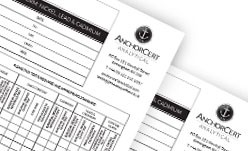Quick Nickel Test
QUICK NICKEL TEST
The UK Nickel regulations have been in force for over thirteen years and most products tested by AnchorCert Analytical now prove to be compliant. Suppliers have invested significant time and money to achieve this. Many now regard testing to be a costly formality which delays lead times unnecessarily.
After extensive research from the established team of nickel experts the AnchorCert Analytical has developed a unique, inexpensive, UKAS accredited Quick Nickel test to resolve this problem.
The Quick Nickel test accurately identifies items which would definitely 'pass', or be ‘likely to fail’ if tested to BS EN 1811:2011. The test can be completed within five days and at a lower price than the full test.
In the majority of cases (more than 98.8%), passing the ‘Quick Nickel test’ indicates that items will pass EN 1811 and comply with the REACH Regulations. This is an acceptable level of certainty from a scientific point of view. Many major retailers are now accepting this as a valuable part of their due diligence programmes.
LEAD TIME - 5 days.
SAMPLES REQUIRED – 1 of each item unless the item is a piercing in this case we would need 5-6 of each item so that we have enough surface area to test.
To read about the UKAS accredited Nickel Release EN1811 full test offered by AnchorCert Analytical, please click here.
QUICK NICKEL TEST - FAQS
1. What is the Quick Nickel test?
a) The Quick Nickel test is a quick, straightforward test which provides a result for each component within five working days.
b) Components are identified ‘pass’ or ‘likely to fail’ if tested to the BS EN 1811:2011 Reference test method for release of nickel from products intended to come into direct and prolonged contact with the skin.
2. How reliable is this new test?
In the majority of cases (more than 98.8%), passing the Quick Nickel test indicates that items will pass BS EN 1811: 2011 and comply with the REACH regulations. This is an acceptable level of certainty from a scientific point of view.
3. How are test results reported?
Unless specific instructions have been received from the Customer, all component part(s) of product(s) shall be tested. Results shall be interpreted as follows:
4. Why is the word likely instead of definitely used in the test report?
a) In spite of a high level of confidence in the accuracy of the Quick Nickel test, we are aware of the lack of repeatability of BS EN 1811:2011. We are therefore obliged to use the word likely.
5. Are the results for the Quick Nickel test accepted in other European countries that require nickel compliant certification and not just in the UK?
a) The Quick Nickel test is unique to the AnchorCert Analytical and extensive research has been carried out comparing EN 1811 to the new test.
b) Currently, the only legally recognised tests for the UK and the EU are BS EN 1811:2011 and EN 12472 (wear and corrosion). Although the new Quick Nickel test can be used as part of your due diligence, you may still wish to test some high risk items to BS EN 1811:2011 and EN 12472.
6. How many samples should I send for testing?
The new test recommends that three different samples are tested “wherever possible”. As a separate issue, due to the lower compliance rate and the increased sensitivity of the tests, an accurate result is only possible if the sample has sufficient surface area to measure it accurately.
The Standard states the minimum surface area required to test is 0.2cm sq, however AnchorCert Analytical identified that a component with less surface area than 0.8cm sq (equivalent to two pairs of earring posts) can influence the results. This could lead to a result being reported as a no decision when it could pass if more surface area were tested. The Laboratory is therefore asking customers to send multiple samples of small components such as post assemblies, crowns, crimps and jump rings.
- ‘Pass’ result indicates that the nickel release from a tested surface is likely to be no greater than 0.88 micrograms per square centimetre per week or less than 0.35 micrograms per square centimetre per week in the case of a post assembly.
- ‘Likely to fail’ result indicates that the nickel release from a tested surface is likely to be equal to or greater than 0.88 micrograms per square centimetre per week or equal to or greater than 0.35 micrograms per square centimetre per week in the case of a post assembly.
Therefore, If submitting post assemblies please submit four pairs of earring posts (eight posts) or If submitting non post assemblies please submit two samples; just in case on the rare occasion an item needs to be resubmitted

7. If the method is confidential, how does one go about determining whether or not it can be used as part of due diligence for nickel free testing?
The detailed step by step instructions to carrying out this test remains the intellectual property of the Assay Office Birmingham and is confidential.
8. If it is not a legally recognised test in the U.K. and the rest of the E.U., on what basis can we, for example, approve this test? Specifically, since the language of the report does not clearly state compliance and rather states just PASS with the likelihood of being less than the maximum requirement of the European Union.
The report for the Quick Nickel test does not use the term Compliant, as it is not the specifically legally required test (EN 1811) to demonstrate compliance. However, the Assay Office Birmingham has sufficient research data to substantiate the accuracy levels of the new Quick Nickel test compared to BS EN1811:2011, and we are confident in recommending this test as part of a due diligence programme.
9. In your professional opinion, if we use your test method on an item that was not one of those that we also did an occasional test of BS EN 1811: 2011 and the authorities in the E.U. found this item in the market to be non-compliant, do we have a legal right to stand on to say that we did proper due diligence even though this is not a legally recognised test?
Yes, the new Quick Nickel test has scientifically proven data to back up the accuracy levels compared to BS EN 1811:2011 and thus, can be used as part of your due diligence.
Your item has been added to the basket
You need to create an account, or login before you can add this item to your basket.




